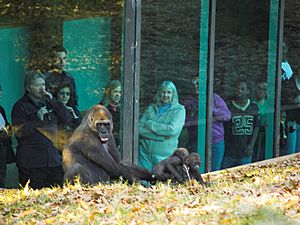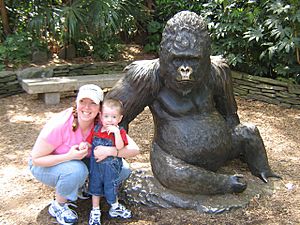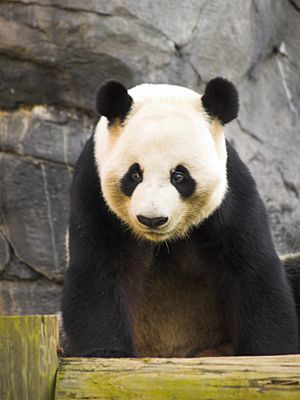Zoo Atlanta facts for kids
 |
|
| Date opened | 1889 |
|---|---|
| Location | Atlanta, Georgia, United States |
| Land area | 40 acres (16 ha) |
| Coordinates | 33°43′57″N 84°22′11″W / 33.73250°N 84.36972°W |
| No. of animals | 1,500 |
| No. of species | 220 |
| Memberships | AZA |
Zoo Atlanta is a popular animal park in Atlanta, Georgia. It is approved by the Association of Zoos and Aquariums (AZA). This means it meets high standards for animal care. The zoo's leader today is Raymond B. King. In the past, around 1984, the zoo was not doing well. But after many changes, it became one of the top zoos by the year 2000.
Contents
History of Zoo Atlanta
Zoo Atlanta started in 1889. A businessman named George V. Gress bought a circus that was closing down. He gave the animals to the city of Atlanta. City leaders decided to put the animals in Grant Park. This is still where the zoo is today.
The first animals at the zoo included a black bear, a raccoon, a jaguar, a hyena, a gazelle, a Mexican hog, lions, monkeys, and camels. In the 1930s, the zoo got even more animals. These came from a private collection owned by Asa G. Candler, Jr.
The 1950s and 1960s were a time of building and fixing things at the zoo. But by the early 1970s, many parts of the zoo were old and needed repairs. In 1970, some people who cared about the zoo started the Atlanta Zoological Society. They wanted to raise money and help the zoo.
In the mid-1980s, the zoo faced tough times. In 1985, it became a private, non-profit group called Atlanta Fulton-County Zoo Inc. It was renamed Zoo Atlanta that same year. For the next 20 years, the zoo worked hard to improve. Many new and exciting animal homes opened. One of these was The Ford African Rain Forest in the late 1980s. In 1999, two giant pandas, Lun Lun and Yang Yang, came to live at Zoo Atlanta.
Exploring the Habitats
The Ford African Rain Forest
Since The Ford African Rain Forest opened in 1988, 21 western lowland gorillas have been born here. Kali and Kazi, who are rare gorilla twins, were born at Zoo Atlanta on October 31, 2005.
Zoo Atlanta is also home to the grandchildren of its most famous gorilla, Willie B. (who lived from about 1959 to 2000). Six of Willie B.'s grandchildren live here: Macy B (born 2005), Merry Leigh (born 2011), and Mijadala (born 2016) are Kudzoo's children. Gunther (born 2006) and Anaka (born 2013) are Sukari's children. Andi (born 2013) is Lulu's child.
The Living Treehouse opened in 2004. It is part of The Ford African Rain Forest. This area has a home for African birds. It also has black-and-white ruffed lemurs and ring-tailed lemurs. Nearby, you can see Angolan colobus monkeys, drills, Schmidt's guenons, and Wolf's guenons. In 2017, two crowned lemurs joined the zoo family.
Trader's Alley and Complex Carnivores
Trader's Alley: Wildlife's Fading Footprints opened in 2010. This exhibit teaches about animals affected by the international wildlife trade. Here, you can see Malayan sun bears and raccoon dogs. In 2011, Complex Carnivores opened next door. This area introduced bush dogs, binturongs, and fossas.
African Savanna
Zoo Atlanta’s African Savanna opened in 1989 as African Plains. It was updated and renamed in 2019. This habitat is home to animals from the grasslands and deserts of Africa. You can see lions, African bush elephants, southern ground hornbills, kori bustards, meerkats, and warthogs. Another savanna area has giraffes, zebras, and ostrich. There is also a naked mole rat colony in its own building. In 2012, the zoo started a giraffe feeding experience. The old elephant home is now for a new animal, the Southern white rhinoceros. A male white rhino named Mumbles came to Zoo Atlanta from the Houston Zoo on May 20, 2020.
Giant Pandas: Our Special Guests
Zoo Atlanta is one of only three places in the U.S. that has giant pandas. Lun Lun (female) and Yang Yang (male) came to Atlanta in 1999. They are on loan from China. Their first cub, a male named Mei Lan, was born on September 6, 2006. A second cub, male Xi Lan, was born on August 30, 2008. A female cub named Po was born on November 3, 2010. Actor Jack Black announced Po's name in 2011. Po was named after Black's character in the Kung Fu Panda movies.
On July 15, 2013, two more cubs were born. These female twins were the first panda twins born in the U.S. since 1987. Their names, Mei Lun and Mei Huan, were announced on ABC's Good Morning America on October 23, 2013. This was 100 days after their birth, which is a Chinese tradition. As of October 2015, Mei Lan, Xi Lan, Po, Mei Lun, and Mei Huan live at the Chengdu Research Base of Giant Panda Breeding in China.
A sixth and seventh cub, both female, were born on September 3, 2016. Their names, Ya Lun and Xi Lun, were announced on their 100th day. Like their older brothers and sisters, these twins will go back to China when they are fully grown. This usually happens when they are between 3 and 5 years old.
Asian Forest
The Asian Forest shows animals from the forests of Asia. Here you can find giant otters, sun bears, Komodo dragons, Sumatran tigers, giant pandas, tanukis, and red pandas. It also has Bornean orangutans and Sumatran orangutans.
The Orangutan Learning Tree Project started at Zoo Atlanta in 2007. This project uses touch screens in the orangutans' habitat. The orangutans can play computer puzzles and games. Visitors can watch their activities on a screen nearby.
The World of Reptiles and Amphibians
The Zoo Atlanta reptile and amphibian team cares for over 450 reptiles and amphibians. These animals represent more than 100 different kinds. Not all of them can be shown at once in the World of Reptiles building. The zoo is the only place that has successfully bred Arakan forest turtles. These turtles are very rare and are in danger of disappearing. A rare Guatemalan beaded lizard hatched at Zoo Atlanta in March 2012.
The World of Reptiles was the zoo's oldest building for public exhibits. It was designed in the late 1950s and opened in 1962. It was home to many snakes, lizards, turtles, tortoises, frogs, toads, and salamanders from all over the world. Some animals shown included black mamba, king cobra, indian star tortoise, Spider tortoise, Alligator snapping turtle, American alligator, and reticulated python. Local Georgia animals included eastern diamond-backed rattlesnake, timber rattlesnake, copperhead, water moccasin, Carolina pygmy rattlesnake, bog turtle, and gopher tortoise.
A new exhibit called Scaly Slimy Spectacular: The Amphibian and Reptile Experience replaced the old World of Reptiles. Construction began in 2013, and the new exhibit opened in 2015.
Outback Station Children’s Zoo
Zoo Atlanta's Outback Station has animals from Australia. These include red kangaroos, Major Mitchell's cockatoos, kookaburras, and a double-watted cassowary. The petting zoo area is home to Saanen goats, Oberhasli goats, Boer goats, Southdown babydoll sheep, Gulf Coast sheep, Nigerian dwarf goats, and two kunekune pigs.
Boundless Budgies: A Parakeet Adventure
Boundless Budgies opened in April 2009. In this exhibit, parakeets flew freely. Visitors could even feed them by hand. This exhibit closed for good in November 2016 to make space for the new African Savannah project.
Conservation Efforts
Zoo Atlanta helps protect animals through the AZA Species Survival Plan. This plan helps make sure that certain animal species survive. Here are some of the animals Zoo Atlanta helps with:
- Aruba Island rattlesnake
- Bali mynah
- Black rhino
- Bongo
- Burmese star tortoise
- Clouded leopard
- African elephant
- Giant panda
- Gorilla
- Golden lion tamarin
- Guenon
- Komodo dragon
- Kori bustard
- Lemur
- Lion
- Orangutan
- Otter
- Radiated tortoise
- Red panda
- Sumatran tiger
Zoo Atlanta also works with other groups around the world to protect animals. They help with issues like the Asian Turtle Crisis and the Global Amphibian Decline. Staff from Zoo Atlanta and the Atlanta Botanical Garden have created safe homes for Panamanian frogs. These frogs are in danger because of a disease called chytrid fungus.
Zoo Leadership
Dr. Terry Maple is a special advisor to Zoo Atlanta. In 1985, he took charge of the zoo's operations. He helped turn the zoo around when it became a private organization and was renamed Zoo Atlanta.
Gallery
See also
 In Spanish: Zoológico de Atlanta para niños
In Spanish: Zoológico de Atlanta para niños










